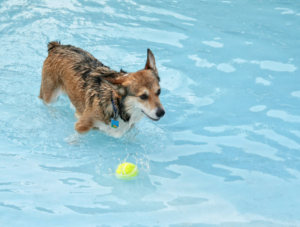Does your dog run with excitement to every body of water in sight? Your dog life vest for swimming can’t walk past a creek or pond without your pup diving into it.
Perhaps your dog treats water like the enemy and will do anything to stay dry. Every dog is different, and not all of them are born with a love of getting wet. But can all dogs swim?
Depending on the breed, your dog might be a natural swimmer or it might be a challenging task. However, whether your dog enjoys taking the plunge or prefers staying on land, it’s essential for safety. Your dog should learn to be comfortable in and around water.
You might want to go boating together, go to the beach, or enjoy a cottage vacation. You might even have a backyard swimming pool or visit somebody who does. Read on for pointers on dog swimming training skills, and tips on water safety.
Not Every Breed Is a Natural Swimmer
It becomes evident that some breeds will be drawn to the water if you think about a breed’s traditional purpose. Some of our friends were born to swim!
These dogs are the Labrador Retriever or the Nova Scotia Duck Tolling Retriever, which are bred to retrieve water birds for the hunter.
Some breeds even have water in their names like the Portuguese Water Dog, developed to work in the water as a fisherman’s helper. The Irish Water Spaniel with the distinctive curly and water-repellent coat.

These dogs have the physical structure to be excellent swimmers, and most will love nothing more than playing in the water.
According to Michele Godlevski, NADD Dock Diving Judge, Certified Professional Dog Trainer, a Certified Canine Behavior Consultant.
He believe that some breeds seem to know how to swim from the moment they see a body of water.
In contrast, others just don’t see the point of swimming.
The Importance of a Dog Life Vest for Swimming
There are also some breeds that have a weight distribution. Bulldogs, for example, is not possible for them to swim very well without a life vest. Short-legged, long-bodied breeds like Dachshunds can also struggle in the water. So, can all dogs swim?
Although it’s a myth that all dogs are natural swimmers. With a life vest and some dog swimming lessons from you, every breed should be able to get around in the water.
Many breeds are natural-born swimmers. Many retrievers and spaniels will swim with little encouragement. But dogs with body types less suited to swimming, like Bulldogs, may need more assistance and should wear a life jacket when swimming.
Regardless of breed, all dogs should wear a life jacket when first learning to swim. Most Pet Supply Stores stock life jackets in many sizes and styles appropriate for all body types. Use a lifejacket with handle and D-ring attach so you can put a leash to guide your dog in the water.
Before using the lifejacket in the water, put it on your dog at home and get him comfortable with it by feeding him dinner while he wears it. As well as rewarding him with treats while he wears it.
Teaching Your Dog to Swim with a dog life vest for swimming
Start in shallow water with your dog on a leash. Ideally, where you too can enter the water. Wade in a few steps and encourage your dog to follow with some tasty treats.
Reward him when he steps in the water, even if he only gets his toes wet. Gradually ask your dog to step further and further into the water until he has to start swimming to reach you.
If your dog likes to retrieve, you can toss his ball or toy a few steps into the water. Each turn throws it a little further so gradually your dog will need to swim to reach his toy.

These steps should be done for several days so as not to overwhelm your dog in one session.
Some dogs can be scared by large bodies of water. Try starting with an empty baby pool in your yard. Get your dog comfortable stepping in while the pool is empty before slowly adding water. Reward your dog for getting in, and he’ll soon be happily jumping in every chance he gets!
Start young! Get your puppy comfortable with water as soon as you bring him home! Your bathtub or a baby pool with an inch or two of water make great places to introduce young puppies. You can also carry small puppies into the water and help them swim back to shore or towards another person.
If your dog doesn’t step off a pool step to start swimming, try a pond or lake. Where they can gradually wade deeper rather than a sudden drop-off in high water.

Just Add Water! 16 Breeds That Are Born to Swim
As mentioned above, while some dogs will dip a toe in the water and maybe join you in the pool. Other breeds are born for the water. These breeds are born to work in the water, whether for hunting, retrieving, rescue, or as all-around helpers. Even though they’re perfectly happy on land. They’re genuinely delighted to hit the beach, lake, or anything wet. If you’re looking for a canine companion that revels in boating and swimming, one of these is perfect for you.
The Importance of a Dog Life Vest for swimming
Godlevski says a life vest is always a good idea. And purchasing and fitting a dog flotation device is the first step in her dog swimming lessons. She advises, “Buy a doggie life vest that fits your dog comfortably. No matter what breed you have, you always want that first experience to be fun and not scary.”
Which means never tossing your dog in the water and letting him figure things out on his own. According to Godlevski, “Throwing a puppy or young dog in the water is not a terrible idea. But it may damage the dog’s courage about swimming for life.
Godlevski has taught many dogs to swim over the years. And she firmly believes that dog swimming is all about courage, which is another reason for the life jacket. A first-time swimmer in a life vest will have more confidence and therefore feel braver than one without.
Even dogs who seem confident, such as those running into the water as they chase a toy or another dog, can end up in trouble. Godlevski says, “They often just chase that dog right into the water without realizing that the surface has changed.”
You don’t want your dog to panic upon realizing the ground has disappeared.
Godlevski says, “In my experience, dogs who run into the water for the first time, do so like a cartoon character running off a cliff. In other words, the drop-off is a complete surprise.” Dogs in a life vest will simply float while they get their bearings and realize they can paddle their feet.
But the dog without a flotation device might panic, gulp water, and drown in the few seconds it takes for the paddling reflex to kick in.
Another reason for the life vest for the newbie dog swimmer is what is calls “front-wheel drive.” In other words, dogs learning to swim only paddle their front feet while their rear legs dangle down usually trying to find the bottom.
On the other hand, if you have a life vest on a dog, the dog’s back stays level with the water. When the dog’s back is level, it occurs to the dog that they do have “four-wheel-drive,” and all four paws paddle. Before you know it, your dog is moving through the water smoothly and confidently.”
Choosing a Dog Flotation Device
Whether your dog is a swimming breed just starting or a kind who needs some extra buoyancy, be sure to choose the most suitable style of a life jacket.
And even the experienced swimmer should have a properly fitting life vest. Your dog might become tired or get disoriented, and the extra buoyancy will help with safety and confidence.
Finally, a doggie flotation device is essential for boating. If your dog falls overboard, there could be rough water or strong currents, and that life vest could be a life-saver.
Look for a life jacket that is durable and made of waterproof materials. It should also be adjustable so you can ensure a snug fit on your dog.
Consider reflective trim if you plan on any evening water-based activities. Along the same lines, the brightly colored fabric is a bonus for visibility.
You might also look for an extra flotation piece under the chin to help keep your dog’s head above water if that kind of additional support is needed.
Also, ensure the device has a handle. That can help you lift your dog out of the water, grab when struggling, and guide your dog to swim.
But Godlevski advises the handle should be sturdy enough to lift the dog out of the water. You might also look for a D-ring that will allow you to attach a leash. That can be useful at public beaches, for example.
